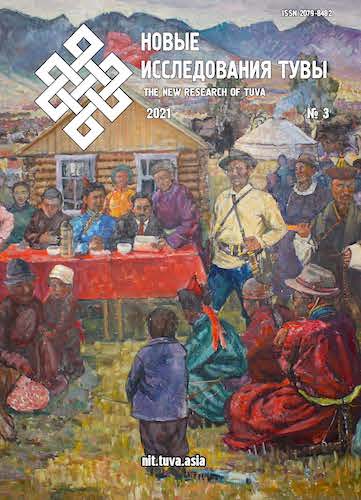Political systems of Mongolian People’s Republic and Tuvan People’s Republic in 1930s and 1940s: changes in the focus of power
DOI:
https://doi.org/10.25178/nit.2021.3.2Keywords:
Tuvan People’s Republic; Mongolian People’s Republic; USSR; Mongolian People’s Revolutionary Party; Tuvan People’s Revolutionary Party; Communist International; Prime Minister; General Secretary; political elite; Peljidiin Genden; Khorloogiin Choibalsan; Yumjaagiin Tsedenbal; Salchak Kalbakkhorekovich TokaAbstract
The article examines and compares the rivalry between prime ministers and general secretaries (‘genseki’) within the political system of the Mongolian People’s Republic and Tuvan People’s Republic in the 1930s and 1940s. Our study is based on documents, some still unpublished, and others preserved at the Russian State Archive of the Social and Political History and the Foreign Policy Archive of the Russian Federation.
We focus on what seems to be the most conspicuous cases of such rivalry and coexistence. On the one end of the spectrum lies the premiership of P. Genden, and the hesitant collaboration of Prime Minister Kh. Choibalsan and the Secretary General of the Central Committee of Mongolian People’s Revolutionary Party Yu. Tsedenbal. On the other, the rule of the First (later General) Secretary of Central Committee of Tuvan People’s Revolutionary Party S. Toka. The struggle for power unfurled under unstable political circumstances, under the influence of USSR and the Communist International (Comintern), and with frequent overlaps of responsibilities assigned by the political documents and legal acts of the time to the Cabinet of ministers and the Party’s Central Committee. We conclude that the outcome of such political struggle mostly depended on its participants’ strength of character. While Mongolian prime ministers (especially Kh. Choibalsan, but for a shorter term and in smaller degree, this is also true for P. Genden) managed to hold the reins, in Tuva the First Secretary was ultimately victorious. Another decisive factor was the degree of support a politician could garner from the USSR – support which largely depended on his loyalty.
References
Baabar (2010) Istoriia Mongolii: ot mirovogo gospodstva do sovetskogo satellita [A History of Mongolia: from global domination to the Soviet satellite]. Kazan, Tatarskoe knizhnoe izd-vo. 542 p. (In Russ.).
Istoriia Mongolii. XX vek [The History of Mongolia in the 20th century] (2007), ed. by G. S. Yaskina. Moscow, IV RAN. 448 p. (In Russ.).
Istoriia Tuvy [The History of Tuva] (2007): in 3 vols. / ed. by V. A. Lamina. Novosibirsk, Nauka. Vol. 2. 430 p. (In Russ.).
Kuz'min, S. L. and Oiuunchimeg, Zh. (2015) Vooruzhennoe vosstanie v Mongolii v 1932 g. [The armed uprising in Mongolia, 1932]. Moscow, OOO “Izdatel’stvo MBA”. 212 p. (In Russ.).
Lamazhaa, Ch. K. (2010) Klanovost' v politike regionov Rossii. Tuvinskie praviteli [The clan politics of Russia's regions: The Leaders Of Tuva]. St. Petersburg, Aleteiia. 208 p. (In Russ.).
Nadirov, Sh. G. (1995) Tsedenbal. 1984 god [Tsedenbal. The year 1984]. Moscow, Vostochnaia literatura. 190 p. (In Russ.).
Ondar, E. M. (2016) K voprosu ob osobennostiakh politicheskogo razvitiia Tuvinskoi Narodnoi Respubliki v 1920–1930-e gody [On the political development of the Tuvan People’s Republic in the 1920–1930s]. Vestnik Tomskogo gosudarstvennogo pedagogicheskogo universiteta, no. 12 (177), pp. 158–164. (In Russ.).
Otroshchenko, I. V. (2010) ‘…Vin zhive tsieiu ideeiu’: panmongol's'kii vektor Kh. Choibalsana [‘…He lives by this idea’: a pan-Mongolian aspect in the policy of Kh. Choibalsan]. Shìdnij svìt, no. 3, pp. 81–91. (In Ukr.).
Otroshchenko, I. V. (2019) Tuvinskaia Narodnaia Respublika nakanune vkhozhdeniia v sostav SSSR glazami sovetskogo diplomata [Tuvan People’s Republic on the eve of accession to the USSR through the eyes of a Soviet diplomat]. The New Research of Tuva, no. 4, pp. 207–215 (In Russ.). DOI: https://doi.org/10.25178/nit.2019.4.17
Otroshenko, I. V. (2021) Kolektyvne kerivnytstvo ta borot’ba za vladu v MNR 1950-kh rr.: Yu. Tsedenbal i D. Damba [Collective leadership and the struggle for power in the Mongolian People’s Republic in the 1950s: Yu. Tsedenbal and D. Damba]. Shìdnij svìt, no. 1, pp. 5–17. (In Ukr.). DOI: https://doi.org/10.15407/orientw2021.01.005
Roshchin, S. K. (2005) Marshal Mongolii Kh. Choibalsan. Shtrikhi biografii [The Marshal of Mongolia Kh. Choibalsan: Notes towards a biography]. Moscow, IV RAN. 158 p. (In Russ.).
Roshchin, S. K. (2008) P. Genden, mongol'skii natsional'nyi lider. Shtrikhi biografii [P. Genden, Mongolian national leader. Notes towards a biography]. Moscow, IV RAN. 160 p. (In Russ.).
Salchak Toka (2015) Ed. by S. K. Shoigu at al. Moscow, Slovo. 544 p. (In Russ.).
Samdan A. A. (2020) Vooruzhennoe vosstanie v Tuve v 1930 g. [Tuvan armed uprising in 1930]. New Research of Tuva, no. 3, pp. 66–80. (In Russ.). DOI: www.doi.org/10.25178/nit.2020.3.5
Shinkarev, L. I. (2006) Tsedenbal i ego vremia [Tsedenbal and his time]: in 2 vols. Moscow, Sobranie. Vol. 1: Liubov'. Vlast'. Tragediia [Love. Power. Tragedy]. 496 p. (In Russ.).
Atwood, C. P. (1999) Sino-Soviet Diplomacy and the Second Partition of Mongolia, 1945–1946. In: Mongolia in the Twentieth Century: Landlocked Cosmopolitan. Ed. by S. Kotkin and B. A. Elleman. New York , London, M. E. Sharpe. Pp. 137–161.
Atwood, C. P. (2004) Encyclopedia of Mongolia and the Mongol empire. New York, Facts on File. 678 p.
Christian, D. (2018) A History of Russia, Central Asia and Mongolia. Vol. II: Inner Eurasia from the Mongol Empire to Today, 1260–2000. Wiley-Blackwell. 656 p. DOI: https://doi.org/10.1002/9781119392606
Dillon, Michael (2020) Mongolia: a political history of the land and its people. London, Bloomsbury I. B. Tauris. viii+224 p.
Myadar, O. (2017) In the Soviet Shadow. Soviet Colonial Politics in Mongolia. Inner Asia, vol. 19, issue 1, pp. 5–28. DOI: https://doi.org/10.1163/22105018-12340077
Radchenko, S. (2012) Carving up the Steppes: Borders, Territory and Nationalism in Mongolia, 1943–1949. Eurasia Border Review, vol. 3, special issue, pp. 9–31.
Socialist Devotees and Dissenters: Three Twentieth-Century Mongolian Leaders (2011). Interviews conducted by Yu. Konagaya and I. Lkhagvasuren, Translated by M. Rossabi, edited and compiled by M. Rossabi. Osaka, National Museum of Ethnology. 298 p.
Stolberg, E.-M. (1997) Stalin und die chinesischen Kommunisten 1945–1953: Eine Studie zur Entstehungsgeschichte der sowjetisch-chinesischen Allianz vor dem Hintergrund des Kalten Krieges. Stuttgart, Steiner. 327 s.
Szalontai, B. (2005), Tsedenbal’s Mongolia and the Communist Aid Donors: A Reappraisal. The Mongolian Journal of International Affairs, no. 12, pp. 91–95. DOI: https://doi.org/10.5564/mjia.v0i12.97
Published
How to Cite
For citation:
Otroshchenko I. V. Politicheskie sistemy Mongol’skoi Narodnoi Respubliki i Tuvinskoi Narodnoi Respubliki v 1930‑1940‑e gg.: izmeneniia sredotochiia vlasti [Political systems of Mongolian People’s Republic and Tuvan People’s Republic in 1930s and 1940s: changes in the focus of power]. New Research of Tuva, 2021, no. 3, pp. 15-33. (In Russ.). DOI: https://www.doi.org/10.25178/nit.2021.3.2
Issue
Section

This work is licensed under a Creative Commons Attribution-NonCommercial 4.0 International License.

Author(s) license holder(s) grant rights for their work to the journal (grantee of a license) under the simple non-exclusive open license in accordance with Art. 1286.1 «Open license for a research work, work of literature or fine arts», Civil Code of the Russian Federation.
New Research of Tuva publishes articles under the Creative Commons Attribution-NonCommercial license (CC BY-NC).
Since it is an open license, author(s) reserve the right to upload the article to their institutional repository, submit it to another journal (if it allows republications), or republish it on their own website (in full, or in part).
However, several conditions apply here:
a) The republished version must always contain the name(s) and affiliation(s) of the author(s), the original title and the hyperlink to the original version on the New Research of Tuva website;
b) It must be in open access, free of charge, and no category of readers must be in any way whatsoever advantaged over general readership.
c) should the contribution be submitted elsewhere by its author(s) without substantial modification (30% or more of original text unchanged), the body of the article should contain a disclaimer that the original version was published in New Research of Tuva (with a link to the respective page)
The CC-BY-NC is a non-revocable license which applies worldwide and lasts for the duration of the work’s copyright.









